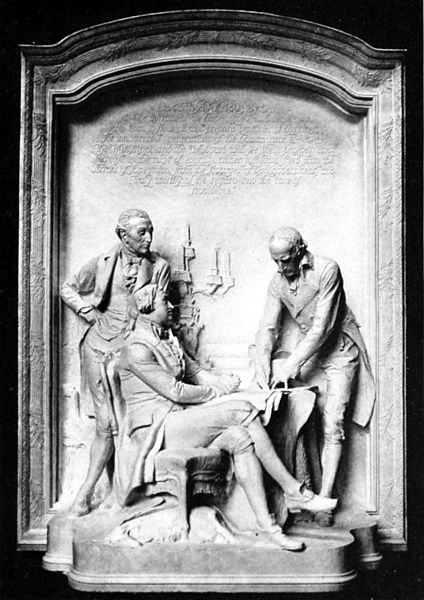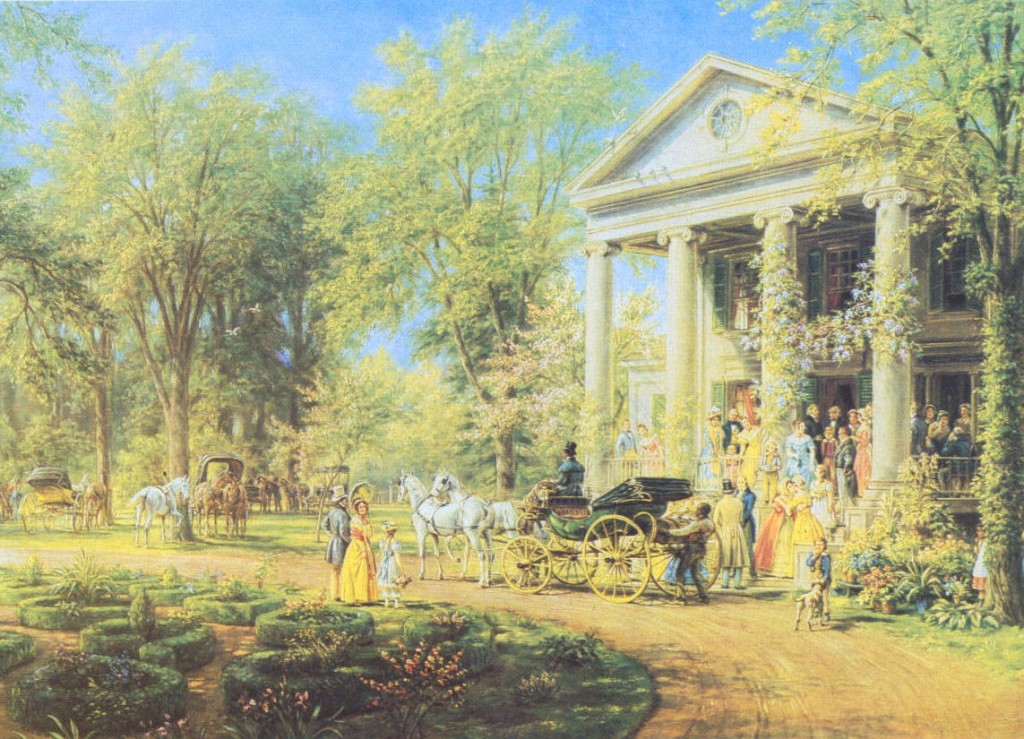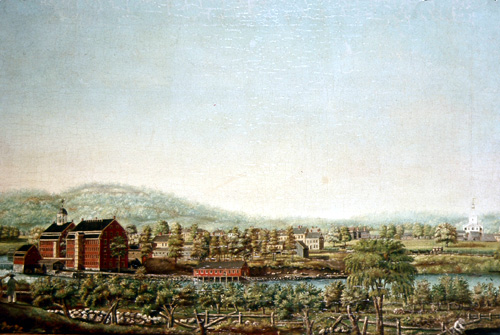
The Waltham Mill, Massachusetts during the Federal Period. The large brick building on the banks of the Charles River is the Boston Manufacturing Co. which still stands today.
The four decades following the ratification of the federal Constitution could well be called an aristocratic era when the presidency was occupied by a succession of gentlemen, whether Virginia planters or Massachusetts lawyers. As the new republic took on an aristocratic cultural character, criticisms against the aristocratic form of government waned and tolerance for elites grew. This was a victory for the aristocracy, which was able to imprint an aristocratic note on political and social life.
In the decade following the Constitution’s ratification, the Federalist elite that had devised it dominated the public, social, and economic life of the new country. In this period defiance of federal authority was greatly diminished and a solid national government was established.

Joseph Dennie, 1768 – 1812, a lawyer in New Hampshire, author and journalist and a Federalist. He wrote for many of the leading Federalist newspapers of that time.
According to Arthur Schlesinger, “the government of wealth and intelligence, as carried on by the Federalists, bore fruit in an unparalleled crop of constructive legislation under Washington and Adams.”(1)
The Federalist program was largely oriented toward the interests of the financial and mercantile elites of the North. This prompted opposition among Southern planters and other rural proprietors, who became allies of the Anti-federalists, or Democratic-Republicans, as this latter faction came to be called.
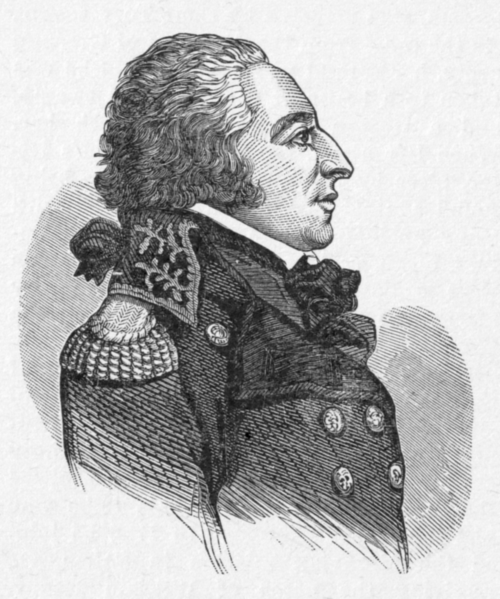
Indeed, many of the Republicans imitated the French radicals (the Jacobins) by cutting their hair short, wearing pantaloons, and addressing one another as ‘Citizen’ Smith or ‘Citizeness’ Jones. Thus, for a time, it was possible to tell a man’s party by his manners and appearance, for the Federalists kept the old-fashioned long hair or powdered wig, knee breeches, and traditional etiquette of the gentleman.
At the end of the eighteenth century the country was politically divided between these two competing parties: the Federalists and the Democratic-Republicans.(2)
The Democratic-Republicans were quick to “develop party organizations…to organize an opposition based on popular support.”(3) Through these organizations, they undermined the grassroots of the Federalist leaders, who nevertheless maintained dominion over the trades and public offices. This emerging sector of Republicans, says William Chambers, was “‘going to the people’ in a virtually unprecedented attempt not only to represent popular interest and concerns, but to monopolize popular opposition to those who held power.”(4)
Instead of attacking the Constitution, as their Anti-federalist predecessors had done, the new Democratic-Republican party entered the political foray parading its democratic interpretation of the Constitution.
The Federalists, in turn, adhered to a more traditional idea of party structure. Members of the Federalist party were linked among themselves only by a commitment to a common program; they did not bother with any party mechanism working at a local level in close contact with the people. To obtain votes, the Federalist candidates counted on their social influence and prestige in their communities.
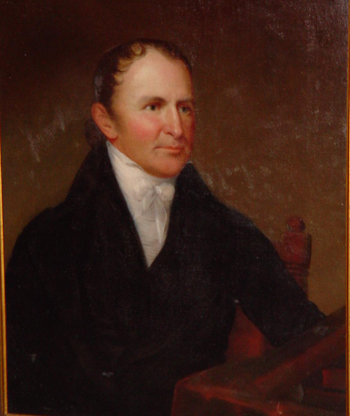
Thomas Worthington, 1773 – 1827, Governor of Ohio, and a Democratic-Republican. Most of Ohio’s earliest political officials were Democratic-Republicans, including Thomas Worthington, who later became one of Ohio’s first two United States Senators.
This blunder in strategy brought about the victory of the Democratic-Republicans in the elections of 1800.Such was the import of the Federalist defeat of 1800 for the course of American political culture that it has often been referred to as the Second American Revolution. The presidency was successively occupied by three representatives of Virginia’s traditional elites—Jefferson, Madison, and Monroe(5)—the so-called Virginia Dynasty. These men, although aristocrats by family and by custom, were leaders of the Democratic-Republican party. This resulted in a virtual single-party government that lasted until 1825.
Defeated for the presidency in 1800, the Federalists never were able to regain office on a national scale and virtually disappeared after the War of 1812.(6)
According to Lipset, one of the causes of the demise was the Federalists’ “unwillingness or inability to learn how to perform as an opposition party in an egalitarian democracy. Some historians suggest that they failed basically because, as men convinced of their ‘natural’ right to rule, they did not believe in parties which appealed to the people.”(7) Former Federalists joined forces as best they could with the democrats or retired from active political life.
As for the Democratic-Republican party, once in power it for the most part continued the policy of its predecessors; nevertheless, it did dispense with much of the formality and ceremony of the Federalist era. Republican “simplicity” became the norm, and the elaborate rules of etiquette the Federalists had introduced as part of the president’s ceremonial were largely suppressed. This did not mean, however, that the air of gentility and distinction proper to Southern planters was altogether absent from the governmental milieu of Washington. Schlesinger comments on this supersedence of elites:
“In the retrospect of history it is clear that political power had shifted from a mercantile aristocracy built on English models to a landed aristocracy fully acclimated to the American environment. The great planters of the South supplied the atmosphere of gentility in which the federal administration at Washington moved and had its being.”(8)
Lipset notes that Jefferson, Madison, and Monroe were all aristocrats and enjoyed a prestige that stemmed from their role in the founding of the country and their leadership in the all-powerful Democratic-Republican party. They used their personal power and class influence to legitimize the national authority and the democratic government.(9)
The aristocratic republic was a regime in which influence and power were shared by the old aristocrats and the new elites. The old aristocracy dominated in some sectors while representatives of the new elites predominated in others. The latter, however, having risen on the social scale in the name of equality, paradoxically aspired to enter the higher classes and distance themselves from those below. The aristocratic republic was also fruit of a revolutionary colonial elite. When it disappeared, a new era opened in the life of America. It is usually referred to as the “Era of the Common Man.”
(1) Arthur Meier Schlesinger, New Viewpoints in American History (New York: Macmillan, 1922), p. 83.
(2) The outbreak of the French Revolution gave new impetus to this division. “The strains endemic in the establishment of a new structure of authority were increased by the fact that the nation and the embryonic parties were divided in their sympathies for the two major contestants in the European war, Revolutionary France and Great Britain” (Seymour Martin Lipset, The First New Nation: The United States in Historical and Comparative Perspective [New York: Basic Books, 1963], p. 39).
In Jefferson’s words, “The form of our own government was to take depended much more on the events of France than anybody had before imagined” (quoted in Daniel Sisson, The American Revolution of 1800 [New York: Alfred A. Knopf, 1974], p. 167).
The period of the Terror in France was particularly feared and rejected by the Federalists, since it appeared to confirm their worst apprehension regarding government by the masses. On the other hand, the revolutionary Terror was initially applauded by many Republicans. “Americans adopted different views about the events in France, the Federalists denouncing and the Republicans applauding them. Indeed, many of the Republicans imitated the French radicals (the Jacobins) by cutting their hair short, wearing pantaloons, and addressing one another as ‘Citizen’ Smith or ‘Citizeness’ Jones. Thus, for a time, it was possible to tell a man’s party by his manners and appearance, for the Federalists kept the old-fashioned long hair or powdered wig, knee breeches, and traditional etiquette of the gentleman.” (T. Harry Williams, Richard N. Current, and Frank Friedel, A History of the United States [to 1876] [New York: Alfred A. Knopf, 1962], pp. 193-194).
(3) Lipset, The First New Nation, p. 33.
(4) William N. Chambers, Parties in a New Nation (New York: Oxford University Press, 1963), p. 65.
(5) Thomas Jefferson was president from 1801 to 1809; James Madison from 1809 to 1817; James Monroe, from 1817 to 1825. They were succeeded by John Quincy Adams, who served from 1825 to 1829.
(6) Cf. The First New Nation, p. 40.
(7) Ibid., p. 40. Cf. William O. Lynch, Fifty Years of Party Warfar 1789-1837 (Indianapolis: Bobbs Merrill, 1931), pp. 122-123.
(8) Schlesinger, New Viewpoints in American History, p. 84
(9) Cf. Lipset, The First Nation, p. 44.
Plinio Corrêa de Oliveira, Nobility and Analogous Traditional Elites in the Allocutions of Pius XII: A Theme Illuminating American Social History (York, Penn.: The American Society for the Defense of Tradition, Family, and Property, 1993), Appendix I, pp. 279-282.
